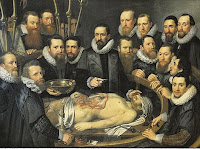 Anatomy
Anatomy
Anatomy teaching has changed over the years, from extensive cadaver-based sessions, to the study of prosections, and more recently, computer-based learning etc.
There are many excellent web based anatomy resources, and some of the best include movie clips and examples of dissected specimens.
Wikipedia provides a useful starting point for general and regional anatomy, with a description of, for example, the anatomy of the neck (of vital importance when considering a 'diagnosis' of strangulation).
The University of Wyoming has an excellent skeletal anatomy resource, with Quick Time movie clips of bones, whilst the Wright School of Medicine, Dayton (USA) has an excellent Quick Time resource including selected dissections.
The Lumen dissector illustrates human dissection, and has an online 'quiz' on anatomical structures (Learn'em) and an excellent cross sectional anatomy resource.
The University of Colorado (USA) has a selection of animated 3D sequences of structures, whilst the University of Michigan has video clips of regional dissections, including that of the anterior neck. An animated illustration of the structures of the larynx can also be found on the 'Anatomia' site (University of Toronto, Canada).
For the 'old school' anatomy students, the 'antique' Gray's anatomy has also been re-produced online, whilst the excellent 39th Edition can also be accessed online to those who have bought the book.
Forensic Anthropology
Several sites provide clear and well illustrated resources for forensic anthropology, including 'Osteointeractive', from the University of Utah (USA) which has a forensic anthropology section.
Paleopathology, including clear images of bone injuries (with movable images of skulls with gunshot wounds) is presented by the University of Wyoming (USA).
Forensic Dentistry
For those interested in dental anatomy and forensic dentistry, Forensic Dentistry Online is the best resource on the web.
 Having hosted an educational website (www.forensicmed.co.uk) for medical students and pathology trainees on forensic medicine and pathology for several years, I thought it was about time to enter the world of bloggers ...
Having hosted an educational website (www.forensicmed.co.uk) for medical students and pathology trainees on forensic medicine and pathology for several years, I thought it was about time to enter the world of bloggers ...
As I discover interesting resources on the web, I will post them on this blog, and would encourage visitors to comment on them, and share their own sites or items of interest!
With so much information available, I will try to be selective, and provide links to the most accurate and 'evidence based' sources (as far as is possible!), and would urge visitors to do the same.
Forensic medicine and pathology are fascinating subjects, and encompas every conceivable branch of medicine, where there are attending legal issues, and so the scope of this blog will necessarily be wide ranging. I hope that you will find these posts of use ... happy reading!
An excellent introduction to forensic science and medicine can be found at the National Library of Medicine (USA) 'Visible Proofs' exhibition website, which includes galleries of images and many educational resources including radio broadcasts and interviews with practitioners.




